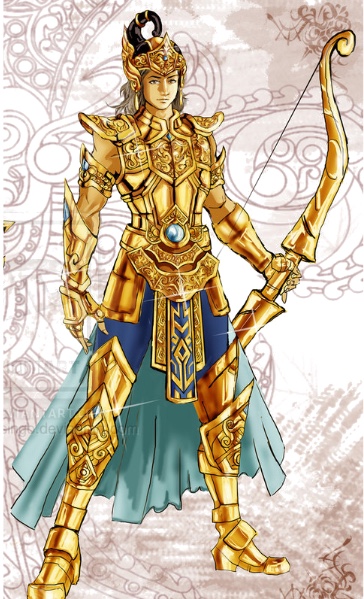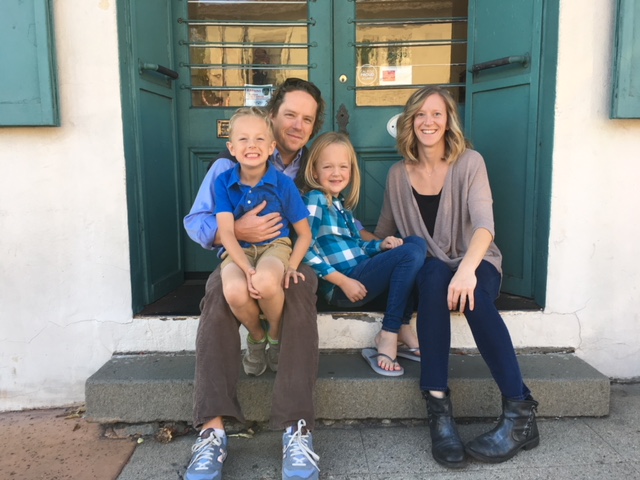Svadharma: Contemplating the Lessons of the Gita, by Peach Friedman
Posted on
It’s not quite accurate to say that I’ve been studying the Bhagavad Gita again this season, because working with this text really feels like living with it. My process of even beginning to understand the layers of meaning and question-asking folded within the this symbolic epic-within-an-epic rely on my ability to make it my own. Suffice to say, I’ve been tangling myself into the teachings these recent months, and my current curiosity lies bundled somewhere within the relationship between Dharma and Svadharma. I’ll briefly unpack these terms for you: Dharma, which has many meanings depending on it’s own context, can be understood for now as our great potential path. Svadharma is like dharma contextualized. It’s the great potential path within the container of the circumstances of our life at present.
For those who aren’t familiar with the Gita, as it’s lovingly referred, the story opens on a battlefield. The Gita is a contextualized text itself — sandwiched within a greater epic, the Mahabharata — and we meet our warrior protagonist, Arjuna, mid-story. An important figure has just been killed in battle, and Arjuna freeze-frames the narrative to pause and grant us a “What the hell am I doing with my life” moment. He drops his weaponry, doubts his purpose, questions everything he’s ever done and is about to do. (Can you relate?) And in this suspended-in-time storybook, the rest of the cast of characters temporarily drift away. I picture this like a scene from a Revolutionary War painting — swords mid-swipe, bodies lurching and lunging, sweat flying — all at once paused so that Lord Krishna could part the tense air and appear grandiose to Arjuna, ready to offer some of the great teachings. In my own imagination he arrives with a lesson book: the complete curriculum of many of the foundational classical yoga teachings.
And so, in sometimes circular and convoluted ways, addressing a range of topics, Krishna’s baseline message to Arjuna is: Stay the course. You’re a warrior. Be a warrior.

When I taught this text in a 300-hour teacher training I led back in 2016, my students grappled with the yogic teaching of ahimsa, or non-killing, paired with this message to stay the warrior’s course. Contemporary peace-loving yogis may not immediately understand the necessity of the battlefield and all her archetypes. But without accessing our inner warrior to play that character, we miss the full spectrum of archetypal patterning.
What? Well, one way of understanding many of the archetypes of the yogic myths and stories is by seeing them as parts of ourselves. Maybe we don’t identify as being a warrior, but we all have a warrior within us. Just as my children dress up to play princess, or doctor, we too need access to the many lives and characters that make up our complex and colorful selves. You could argue that the play acting is essential for emotional expression, maybe even for psychological health. Certainly for creativity. But Arjuna isn’t playing warrior: he is a warrior, was born to be a warrior, and will die a warrior.
This is his svadharma. It’s the path he’s been given by caste of his birth. Krishna circles around to say again and again, Don’t fight who you are. Lay back into being in battle, Arjuna, for here you are.
For here you are. And, here you are. And me. And all of us. Finding ourselves dropping our own metaphorical swords in a struggle to swim upstream, away from the context of our own lives. I ask again: can you relate? I know I can. How many times have I had my own “What the hell am I doing with my life?” moment, or like that Talking Heads song, “This is not my beautiful house. This is not my beautiful wife.” In other words: how did I even get here!?
The lesson in svadharma is to place the pure potentiality of our path within the context of reality. For me, stage of life becomes a relevant fixture here. What may have been possible ten years ago is no longer possible, and in fact, instead, some other things are possible now. I’ll get specific and personal for a moment.

At the end of 2016 I found myself having a “What the hell are you doing with your life?” moment. I was living in Alabama, running a successful yoga studio and teacher training school, and raising my two children, then in Kindergarten and second grade. The national presidential election was stressing me out, my mother-in-law back in California was fighting Ovarian cancer, and my marriage needed…tending to. We had moved to Alabama seven years before, for my husband’s job, and though he and I were both thriving in our careers, something wasn’t right. In the spirit of a warrior’s passion, I pulled my sword, placed both feet firmly on the ground, bare-breasted and wild warrioress hair waving in the wind, and drew from my wellsprings all the strength I had to announce to my husband, in what felt like a heroic gesture, “We’re moving back to California.” As it turns out, my putting my foot down moment was unnecessary. Husband agreed easily, we told the kids we were moving while they were in the bathtub one night, and within eight weeks we had sold our house, my business, pulled the kids out of school, and were out of there.
Both of us hovering around 40, with two child-sized responsibilities, uprooting like this felt like a bold move. We were leaving behind a comfortable life and the best jobs either of us had ever had. Stability. We joked, “We’re doing this like we’re twenty year olds!” But we did it anyway. I lived for a few months with our two children in my in-laws house in the Bay Area while Jeffrey traveled up and down the state of California looking for work. He landed a job at his alma mater, Cal Poly, in San Luis Obispo, and the kids and I followed.

Dharma. Potentiality, pure path, great truth and matter. Svadharma: context, reality, container. I landed in SLO, as it’s affectionately called, and found myself in a warm and very full pool of yoga teachers. As a woman who has been known for manifesting a vision in record time, I knew something was different now. Looking around, slowly getting my footing, the scenery had changed. What I was able to create in a previous context was not possible in this new city. In my small Alabama town in 2010 there was little to no yoga — it was clear when I arrived there what my svadharma was: to build a studio, to run a training school. My dharma as a teacher became contextualized, given focus. And now, in 2018 in coastal California, it would not make sense to force the same outcome, the same specific manifestation of my dharma.
What is my svadharma now? How do I know what step to take next? How is this new context meant to inform my greater dharma? In some ways, I still feel like I’m in freeze-frame with Arjuna, awaiting wise counsel from Lord Krishna in order to see clearly what I may be yet unable to see. I don’t know my next big move, but I do know this: I will be unable to proceed, to take the next step, until I can know clearly where I am now. Until I can understand and place myself in context: stage of life, environment, social belonging, and more. If my dharma is to teach, and the context of my new life is almost-forty-living-in-coastal-California-with-a-husband-and-two-kids-and-a-saturated-yoga-market then the actions of my svadharma will be born of this present moment, and not any replication of the past, or dream of the future.
Clarity is a rare gift. Most days we fumble. If yoga looks like a practice for me, then it’s the practice of pausing to sense what is real, and from that place, discern my next move. This is what Arjuna does in the Bhagavad Gita. He’s gifted the pause of a frozen battlefield to place himself more accurately in context. While we can’t always hit the pause button on life, we can slow our pace so that we act with presence of mind and awareness of reality, rather than forcing a situation out of urgency, fear, or doubt.
When Arjuna hits the play button again, he returns to active battle infused with knowledge from Krishna’s teaching. But the real gift of knowledge is usually more question-asking. As I grapple lovingly, and frustratingly, with the Gita, and likewise wrestle with the makings of my own life, I know I’m on the right path if I’m pausing to sometimes ask, “What the hell am I doing with my life?”

Bio: Peach Friedman, E-RYT 500, has been studying the system of yoga since 1997, and began teaching yoga + other movement practices in 2001.
Peach’s classes emphasize skillful alignment. Her teaching style is clear, direct, and purpose-driven. She is known for challenging classes that aim to balance the relationship between stability and mobility, as well as the relationship between the pose and the person.
Also the author of the internationally acclaimed memoir, Diary of an Exercise Addict, Peach has worked for over a decade helping women recover from eating disorders.
Peach’s most influential teachers include Noah Mazé, Cori Martinez, and Livia Cohen-Shapiro.
Peach recently sold her yoga studio in Auburn, Alabama, and has relocated to San Luis Obispo, California. She has two kids, a cute husband, lots of bikes, and a love of good chocolate.
